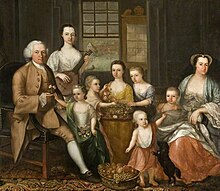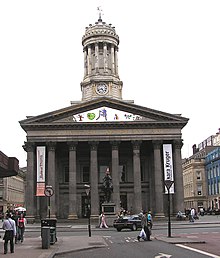
The Province of Maryland was an English and later British colony in North America from 1634 until 1776, when it made common cause with the group of Thirteen Colonies in rebellion against Great Britain and, finally in 1781—as the 13th signatory to the Articles of Confederation—it ratified its perpetual union with that group as the state of Maryland. The province's first settlement and capital was St. Mary's City, located at the southern end of St. Mary's County, a peninsula in the Chesapeake Bay that is bordered by four tidal rivers.

This article deals with the history of the city of Glasgow, Scotland.
The City of Glasgow Bank was a bank in Scotland that was largely known for its spectacular collapse in October 1878, which ruined all but 254 of its 1,200 shareholders since their liability was unlimited.
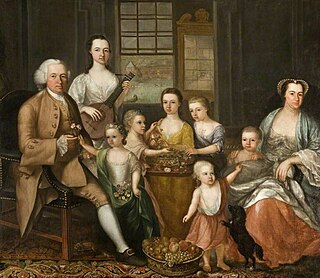
John Glassford was a Scottish merchant and planter. One of the most prominent Tobacco Lords of Scotland, Glassford owned tobacco-producing slave plantations in the British North American colonies of Virginia and Maryland, for which he has become controversial in the 21st century.
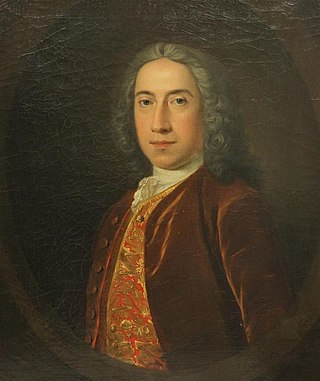
Richard Oswald was a Scottish merchant, slave trader and diplomat. During the American Revolution, he served as an advisor to the North ministry on trade regulations and the best way to respond to the American War of Independence. Oswald is best known for being one of the British peace commissioners who negotiated the Peace of Paris in 1782.
During the British colonization of North America, the Thirteen Colonies provided England with an outlet for surplus population as well as a new market. The colonies exported naval stores, fur, lumber and tobacco to Britain, and food for the British sugar plantations in the Caribbean. The culture of the Southern and Chesapeake Colonies was different from that of the Northern and Middle Colonies and from that of their common origin in the Kingdom of Great Britain.

The Ramshorn, is a deconsecrated church building located on Ingram Street in the Merchant City area of Glasgow, Scotland. It is home to SCILT, Scotland's National Centre for Languages and the Confucius Institute for Scotland's Schools (CISS), both centres within the University of Strathclyde. The building is owned by the University, which bought the church in 1983 and used it as a theatre and performance space from 1992 until 2011.
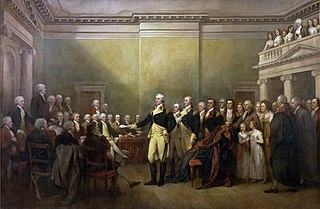
Then Province of Maryland had been a British / English colony since 1632, when Sir George Calvert, first Baron of Baltimore and Lord Baltimore (1579-1632), received a charter and grant from King Charles I of England and first created a haven for English Roman Catholics in the New World, with his son, Cecilius Calvert (1605-1675), the second Lord Baltimore equipping and sending over the first colonists to the Chesapeake Bay region in March 1634. The first signs of rebellion against the mother country occurred in 1765, when the tax collector Zachariah Hood was injured while landing at the second provincial capital of Annapolis docks, arguably the first violent resistance to British taxation in the colonies. After a decade of bitter argument and internal discord, Maryland declared itself a sovereign state in 1776. The province was one of the Thirteen Colonies of British America to declare independence from Great Britain and joined the others in signing a collective Declaration of Independence that summer in the Second Continental Congress in nearby Philadelphia. Samuel Chase, William Paca, Thomas Stone, and Charles Carroll of Carrollton signed on Maryland's behalf.

Tobacco cultivation and exports formed an essential component of the American colonial economy. It was distinct from rice, wheat, cotton and other cash crops in terms of agricultural demands, trade, slave labor, and plantation culture. Many influential American revolutionaries, including Thomas Jefferson and George Washington, owned tobacco plantations, and were hurt by debt to British tobacco merchants shortly before the American Revolution. For the later period see History of commercial tobacco in the United States.

The British credit crisis of 1772–1773 also known as the crisis of 1772, or the panic of 1772, was a peacetime financial crisis which originated in London and then spread to Scotland and the Dutch Republic. It has been described as the first modern banking crisis faced by the Bank of England. New colonies, as Adam Smith observed, had an insatiable demand for capital. Accompanying the more tangible evidence of wealth creation was a rapid expansion of credit and banking, leading to a rash of speculation and dubious financial innovation. In today’s language, they bought shares on margin.

Samuel Vassall (1586–1667) was an English merchant, politician, and slave trader who sat in the House of Commons from 1640 to 1648. Vassall was the majority shareholder of the Guinea Company, founded in 1651. Samuel Vassall was 77 when he left London for Carolina in 1663. He died in the America colonies in 1667.
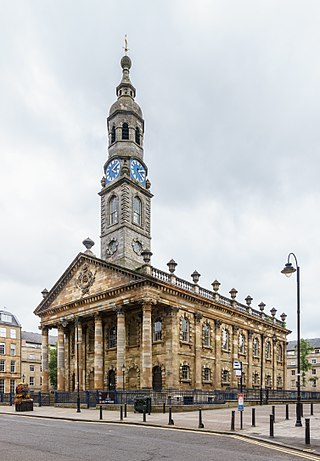
St Andrew's Square is a public square in the city of Glasgow, Scotland and lies to the south east corner of Glasgow Cross, close to Glasgow Green. The square is noted for its immense 18th-century classical church, St Andrew's in the Square, from which the square takes its name. The church was completed in 1758, to the designs of architect Allan Dreghorn and master mason Mungo Naismith and is among the finest of its type anywhere in Britain. The interior has lavish 18th century rococo plasterwork. The building is Category A listed. It is one of six squares in the city centre.
William Cunninghame of Lainshaw (1731–1799) was a leading Tobacco Lord who headed one of the major Glasgow syndicates that came to dominate the transatlantic tobacco trade. Most of the tobacco shipped from American slave plantations was sold to France. He later also made a further fortune stockpiling tobacco bought at keen prices shortly before the American Revolution, assuming that Great Britain would not be able to retain control over her rebellious colonies, and then selling at high prices. Cunninghame's neo-classical house on Glasgow's Queen Street today houses the collection of the Gallery of Modern Art.

The Ramshorn Cemetery is a cemetery in Scotland and one of Glasgow's older burial grounds, located within the Merchant City district, and along with its accompanying church, is owned by the University of Strathclyde. It has had various names, both official and unofficial: North West Parish Kirkyard; St David's Kirkyard; and Ramshorn and Blackfriars. The latter name tells of its link to Blackfriars Church, linking in turn to the pre-Reformation connection to the Blackfriars Monastery in Glasgow.
Sir Thomas Martin Devine is a Scottish academic and author, who specializes in the history of Scotland. He is Scotland's most celebrated historian, having been knighted and made and Officer of the Order of the British Empire for his contributions to Scottish historiography. Officer of the Order of the British Empire, and is known for his overviews of modern Scottish history. He is an advocate of the total history approach to the history of Scotland. He is professor emeritus at the University of Edinburgh, and was formerly a professor at the University of Strathclyde, the University of Aberdeen.

Andrew Buchanan of Drumpellier (1690–1759) was a Scottish tobacco merchant who was one of Glasgow's "Tobacco Lords". He served as Lord Provost of Glasgow from 1740 to 1742. Buchanan Street in Glasgow is named after him.
Archibald Ingram (1699–1770) was an 18th-century tobacco lord who served as Lord Provost of Glasgow from 1762 to 1764. Ingram Street in the city centre was named in his honour in 1781.
Lawrence Dinwiddie of Germiston (1696–1764) was an 18th-century Scottish tobacco lord who served as Lord Provost of Glasgow from 1742 to 1744.

The planter class was a racial and socioeconomic caste which emerged in the Americas during European colonization in the early modern period. Members of the caste, most of whom were settlers of European descent, consisted of individuals who owned or were financially connected to plantations, large-scale farms devoted to the production of cash crops in high demand across Euro-American markets. These plantations were operated by the forced labour of slaves and indentured servants and typically existed in tropical climates, where the soil was fertile enough to handle the intensity of plantation agriculture. Cash crops produced on plantations owned by the planter class included tobacco, sugarcane, cotton, indigo, coffee, tea, cocoa, sisal, oil seeds, oil palms, hemp, rubber trees, and fruits. In North America, the planter class formed part of the American gentry.
Dunlop Street is a thoroughfare in the city of Glasgow, the largest city in Scotland. The street runs east from Maxwell Street running east parallel to Clyde Street before making a right turn to join Clyde Street.
